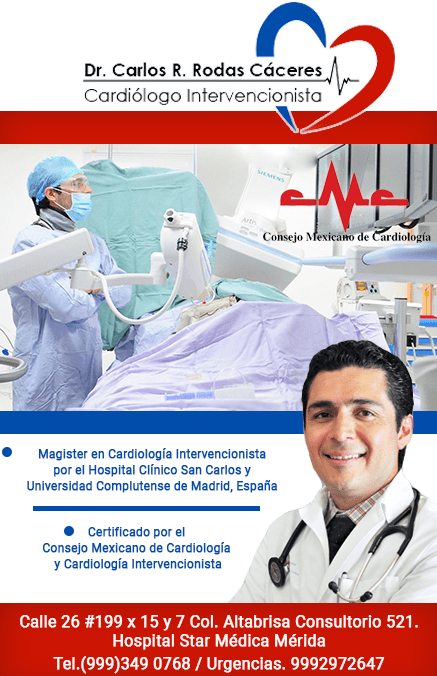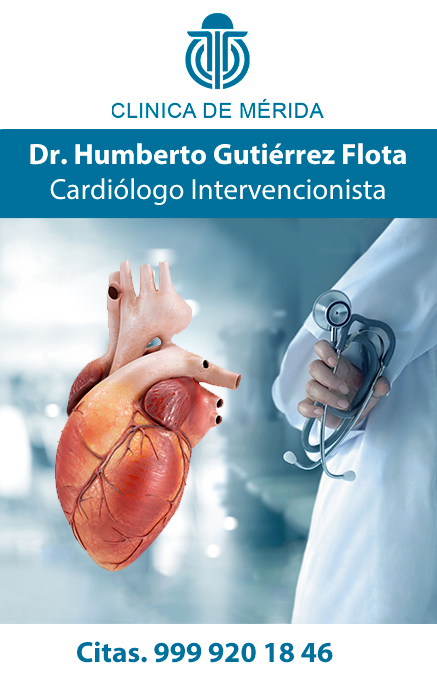Merida cardiology is the branch of internal medicine, which deals with the conditions of the heart and the circulatory apparatus.It is included within the medical specialties, that is, it does not cover surgery, even though many cardiological diseases are surgical sanction, so a cardiological team is usually composed of cardiologists, cardiac surgeon and physiatrist, also integrating other specialists when thePatient land requires it.
Interesting articles
Caridologists in Merida at your fingertips
Adults with congenital heart disease and Covid-19 pandemic
The pandemic by Covid-19 implies a great challenge in the management of adult patients with congenital heart disease (CCA).This population presents a great diversity of cardiac injury and physiopathological conditions that make it difficult to make a risk stratification of adverse events.In the absence of observational studies, the recommendations of the experts are important.
This document shows an overview of the characteristics of the SARS-COV-2 virus, the strategies in the diagnosis of the disease and the management of Patients with CCA, with special dedication to the highest risk of complications.
.
The authors offer pragmatic recommendations regarding the prevention and care circuits of patients with CCA.First, they classify patients under, intermediate and high risk based on anatomical criteria (specific injuries) and functional.They consider patients with complex cyanotic affectations, dull univeentricular hearts, heart failure, severe valvular disease or pulmonary hypertension.
ver artículo completo
Coronavirus and its cardiovascular impact
The disease by Coronavirus (Covid19) caused
By "Severe Acute Respiratory Syndrome Coronavirus 2" (SARS-COV2), it began in Wuan, China, but its rapid internationally dissemination has led to the World Health Organization to declare it a pandemic on March 11.
It is important that cardiologists and the medical community in
General Know your impact on a cardiovascular level (CV).We must know that the information until today comes, mostly from China, of retrospective and unicentric analyzes, or of reported cases.Therefore, statistical data is probably not real, but they are available to date;And surely any of them have modifications at the time you are reading this review.
La infección por COVID19 impacta de manera directa la enfermedad cardiovascular (ECV). Patients with CVD are predisposed to Covid19 infection, and at greater risk of adverse events, in addition, infection by itself is associated with cardiovascular complications.2.3 On the other hand, the therapies used for Covid19 can interact with cardiovascular drugs or impact on the CV system.
See full article.
Holter test by cardiologists in merida
A Holter monitor in Merida is a small portable device that maintains a cardiac rhythm record. Your doctor may request you use a Holter monitor one to two days. During that time, the device records all heartbeat.
A Holter monitor study is usually done after a traditional study to evaluate the heart rate (electrocardiogram), especially if the doctor could not obtain sufficient information about the heart's state by electrocardiogram.
Your doctor uses the information captured on the Holter monitor to determine if you have any problems with the heart rate. If a standard HOLTER monitor does not capture irregular heartbeat, your doctor may suggest you use a wireless Holter monitor, which can work for weeks.
Although the use of a Holter monitor can be somewhat uncomfortable, you need to know that it is an important study that can help your doctor diagnose a possible disease.
Why is
If you have signs or symptoms of a heart problem, as irregular heartbeats (arrhythmia) or fainting without apparent cause, the doctor may order a test called "electrocardiogram". An electrocardiogram is a brief and non-invasive test that uses electrodes adhered to the chest to control the heart rate.
However, electrocardiogram sometimes does not detect any irregularity in the heart rate, since you are only connected to the machine for a short period. If your signs and symptoms suggest that an occasionally irregular heart rate could be causing your condition, the doctor can recommend using a Holter monitor for one day or more.
During that time, the Holter monitor can detect irregularities of heart rhythm that an electrocardiogram could not detect.
The doctor can also sort a Holter monitor if you have a heart disease that increases the risk of an abnormal heart rate. The doctor may suggest you use a Holter monitor for one or two days, even if you have not had symptoms of abnormal heartbeat.
Risks
There are no significant risks related to the use of a Holter monitor, beyond possible discomfort or irritation of the skin in the areas where the electrodes are placed.
However, the Holter monitor can not get wet because it would be damaged. Do not swim or bathe all the time you use the Holter monitor. However, if you have a wireless Holter monitor, they will teach you how to disconnect and reconnect the sensors and the monitor so you can shower or bathe.
Holter monitors are generally not affected by other electrical devices. However, avoid metal detectors, magnets, microwave ovens, electric blankets, razors and electric toothbrushes while use it, as these devices can interrupt the signal from the electrodes to the Holter monitor. Also, keep the cell phones and portable music players at 6 inches (15 cm) at least from the monitor, for the same reason.
How to prepare
If the doctor recommends the control using a HOLTER monitor, the device will be placed during the programmed query. Take a bath before the consultation, unless the doctor tells you otherwise. Most monitors can not be removed and should remain dried once the control begins.
A technician will place you in the thorax electrodes that detect heartbeat. These electrodes are approximately the size of a silver dollar coin. In men, a small amount of hair could be shaved to ensure adhesion of the electrodes.
Afterwards, the technician will connect the electrode to a recording device with several cables and will give you instructions on the proper form of carrying the recording device so that it can record the data transmitted from the electrodes. The recording device has approximately the size of a deck of cards.
will you ask you to write down in a diary all the activities you do while you have the monitor. It is especially important to record in the newspaper any symptom of palpitations, interruptions in heartbeat, lack of air, chest pain or stunning. They usually will give you a form so you can better record the activities and any type of symptom.
Once the monitor is placed and that they have given the instructions on how to take it, you can leave the doctor's office and resume your normal activities.
Cardiac pacemaker
It is a small device operated with batteries that perceives when the heart is beating again or in a very slow manner.He sends a signal to the heart, which makes him beat at the right rhythm.
Description
The newer pacemakers weigh only 1 ounce.Most pacemakers have 2 parts:
The generator contains the battery and information to control the heartbeat.
Derivations are wires that connect the heart to the generator and carry electrical messages to that organ.
A pacemaker must be implanted under the skin. This procedure takes about 1 hour in most cases. You will be given a sedative to help you relax. You will be awake during the procedure.
A small incision is made (cut), almost always on the left side of the chest under the clavicle. The pacemaker generator is then placed under the skin in this location. The generator can also be placed on the abdomen, but this is less common.
Using X-ray images to see the area, the doctor places the leads through the cut, inside a vein and then to the heart. The derivations are connected to the generator. The skin closes with sutures.
Most people go home after 1 day after the procedure.
Two types of pacemakers are used only in medical emergencies: transcutaneous and transvenous. These pacemakers are not permanent.
Why the procedure is carried out
Pacemakers can be used for people who have heart problems that lead their heart to palpitate very slowly. A slow heartbeat is called bradycardia. Two common problems that cause a slow heartbeat are sinus node disease and atrioventricular block.
When your heart beats too slowly, it is possible that the body and brain do not receive sufficient oxygen. Symptoms can be dizzy, fatigue, episodes of fainting and shortness of breath.
Some pacemakers can be used to interrupt a heart rate that is too fast (tachycardia) or that it is irregular.
Other types of pacemakers for severe heart failure can be used. These are called biventricular pacemakers. They help coordinate the heartbeat of the heart ventricles.
Most of the biventricular pacemakers today can also work with an implantable cardiovers (CDI), which restore normal cardiac beats.
Risks
Possible complications of surgery for pacemaker are:
abnormal heart rhythms
Bleeding
Lung puncture.This is rare.
infection
Heart drilling that can lead to bleeding around him.This is rare.
A pacemaker perceives if the heartbeat is above a certain rate.When it exceeds that rate, the pacemaker stops sending signals to the heart.You can also perceive when the heartbeat is too slow.In that case you will automatically turn on and start regulating the heart again.
before the procedure by cardiologists in Merida
Always tell your health care provider what drugs is taking, including drugs or herbs that you have bought without a recipe.
The day before surgery:
Take a shower and wash very well.
You may be asked to wash all the neck body down with a special soap.
on the day of surgery:
You can not be asked not to drink or eat anything after midnight the night before the procedure.This includes chewing gum and encouragement for breath.Rinse your mouth with water if you feel dry, but be careful not to swallow the water.
Take the drugs that were told with a small sip of water.
Your health care provider will tell you what time you should get to the hospital.
after the procedure
You probably can go home after 1 day. You must be able to return quickly to your normal level of activity.
Ask your care provider how much you can use the arm on the body side where the pacemaker was placed. It is possible that they advise you not to raise anything that weighs more than 10 to 15 pounds (4.5 to 7 kg) and avoid pushing, pulling or twisting the arm for 2 to 3 weeks. They can also ask you not to raise your arm over your shoulder for 6 weeks.
When you leave the hospital, they will take a card to take it in the portfolio. This card contains a list of the details of your pacemaker and has the contact information for emergencies. You should always carry this card in the portfolio.
Expectations (prognosis)
Pacemakers can help keep rhythm and heart rate at a safe level for you. The pile of the pacemaker lasts approximately 6 to 15 years. Your care provider will review it regularly and will replace it when necessary.
Arrhythmias
It is a heart rate disorder (pulse) or heart rate.The heart can beat too fast (tachycardia), too slow (bradycardia) or irregularly.
Causes
Normally, your heart works as a bomb that carries blood to the lungs and the rest of the body.
To help this happen, your heart has an electrical system that guarantees that it contracts (purchases) in an orderly manner.
The electrical impulse that gives the sign to the heart to contract begins in the Sinoauricular nodule (also called a sinus nodule or nodule SA), which is the natural pacemaker of the heart.
The signal leaves the syauuricular nodule and travels through the heart along a series of electric routes.
Different nervous messages give you the signal to the heart to palpitate slower or faster.
Arrhythmias are caused by problems with the electrical driving system of the heart.
Abnormal signals can be presented (extra).
Electrical signals can be blocked or delayed.
Electrical signals travel on new or different routes through the heart.
Some common causes of abnormal heartbeat are:
Abnormal levels of potassium or other substances in the body.
Heart attack or myocardial damage for a past heart attack.
heart disease that is present at birth (congenital).
Heart insufficiency or heart enlargement.
hyperthyroidism.
Arrhythmias can also be caused by some substances or medications, such as:
Alcohol, caffeine or stimulating drugs.
Medications for the heart or blood pressure.
Cigarette consumption (nicotine).
Drugs that simulate the activity of the nervous system.
Medications used for depression or psychosis.
Sometimes, the medications used to treat a type of arrhythmia will cause another type of abnormal heart rhythm.
Some of the most common abnormal heart rhythms are:
Fibrillation or auricular flutter
Restored tachycardia in the Aurrioventricular nodule (AVRNT)
Cardiac lock or atrioventricular
Multifocal headset tachycardia
Supraventricular paroxysmal tachycardia
Sick sinus syndrome
Tachycardia or ventricular fibrillation
Wolff-Parkinson-White Syndrome
How to prevent a "/ H4 infarction>
We all have heard of infarctions, especially in older people or people who do not follow a balanced feed or do not practice any type of sport or exercise. The heart attack or infarction occurs when a heart muscle is damaged or does not receive enough oxygen. Many problems related to the heart are produced by blockages or plugs in the arteries, which transport the blood & ldquo; clean “ From the heart to different parts of the body. On other occasions, the problem comes from blood clots.
according to Cardiologists experienced in Merida The most common symptoms of a heart attack are pressure and pain in the chest. On many occasions, accompanied by a high sweating, nausea and vomiting. It usually happens that this intense pain extends from the chest to the left arm and sensation of drowning (lack of air). If one day you have any of these symptoms do not think about it and quickly go to the emergency room.
Actually, the most sensible, in case of emergency for infarction, it is not to go on our own but to call the emergency telephone to move in ambulance. When we call, they may indicate any action to perform while ambulance arrives and, logically, we must follow the instructions at the bottom of the letter.
Coronary artery disease (coronopathy)
Coronaryopathy means the decrease of the caliber of one or more of the coronary arteries (the vessels that supply blood to the heart). This decrease of the caliber is due to the accumulation of a plate (a deposit formed by cholesterol, other fats and calcium) in the walls of the arteries, a process called atherosclerosis (hardening of the arteries). If the plate becomes fragile and breaks, a blood clot will quickly be formed that will obstruct the circulation of blood into the artery and can cause a myocardial infarction (the death of the cardiac muscle irrigated by the obstructed artery), often called attack al Heart.
Symptoms
Coronaryopathy can develop slowly without any symptoms.
angina: chest pain that can radiate on shoulders, arms or jaw (or sometimes limited to one of these regions). Angina usually takes over several minutes and can be related to activity, exercise, copious meals, cold or stress. If more than 15 minutes are prolonged, the affected person runs the risk of experiencing a myocardial infarction.
The symptoms of a heart attack include intense pain in the chest, shortness of breath, sensation of cold sweat and nausea. The demonstrations can be different in males and women, and is more likely that, after activity, a woman refers an unusual fatigue rather than chest pain.
If you or any known person presents symptoms of a heart attack, immediately call the medical emergency service so that they submit to an exploration.
Diagnosis
In an emergency service various examinations can be practiced to determine if a person is a victim of a heart attack. Blood tests can detect certain substances released in the blood during a heart attack. An electrocardiogram (ECG) can highlight the signs of a heart attack, as well as the presence of cardiac arrhythmias.
Treatment applied by the cardiologist
To relieve angina, the doctor can prescribe nitrates (such as nitroglycerin).
Drugs that fluidify blood (anticoagulants), such as aspirin, can help reduce the risk of blood clots to form.
Statins (a type of drugs that reduces hypocolesterolemetic cholesterol concentrations) and beta blockers (one type of drugs that reduces blood pressure values [antihypertensive]) can prevent infarctions and premature deaths.
Percutaneous Coronary Intervention (ICP): Through a catheter, a fine balloon is advanced by the obstructed artery and swell, which exerts pressure on the plate and widens the caliber of the artery with the consequent increase in the flow blood; Then, a stent (a small flexible tube) is implanted in the artery to keep it open.
Surgery by bypass of the coronary artery: a vein of another part of the body is used to divert the blood from a coronary artery with an important obstruction.
Prevention
do not smoke.
Perform exercise, at least, for 30 minutes a day.
Keep hypertension controlled, blood concentration of cholesterol and diabetes with an appropriate diet, performing exercise and, if necessary, with medications.
Follow a diet rich in cereals, fruit and vegetables and drop in saturated fat.
The consumption of a daily aspirin can reduce the risk of infarction, particularly in males over 50 years.
Find the best cardiologists in merida
Do you want to be part of the cardiologists in Merida
See more
Privacy Policy
The information presented here is the responsibility of the advertiser, Directory of Cardiologists in Merida It drops from any claim or problem with any of the advertisers.
Contact us







